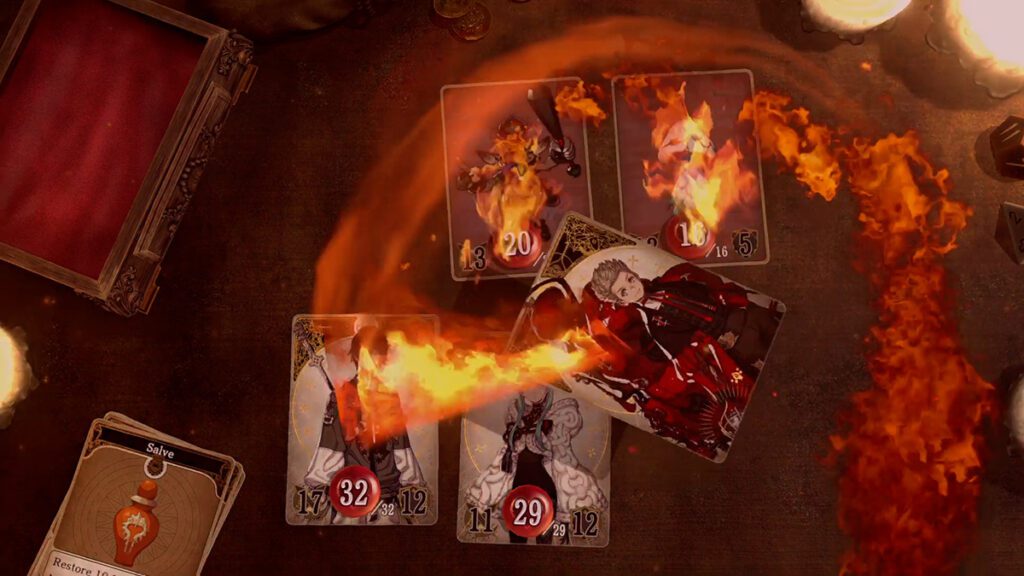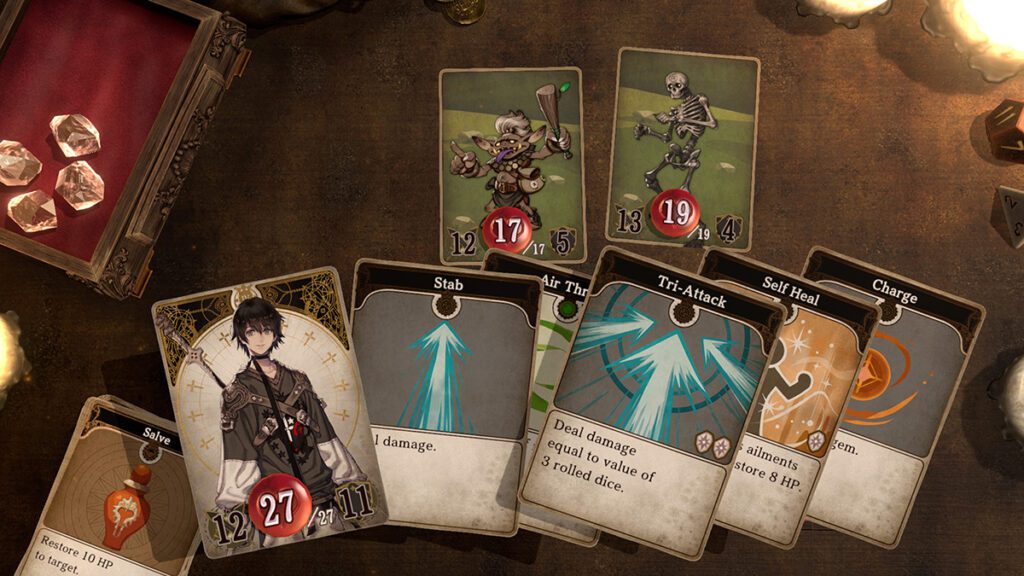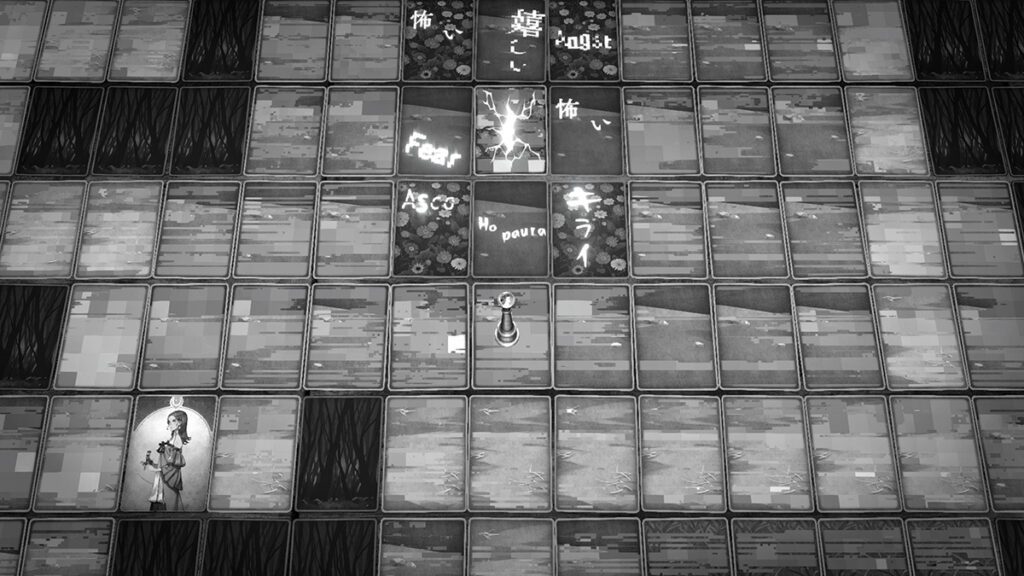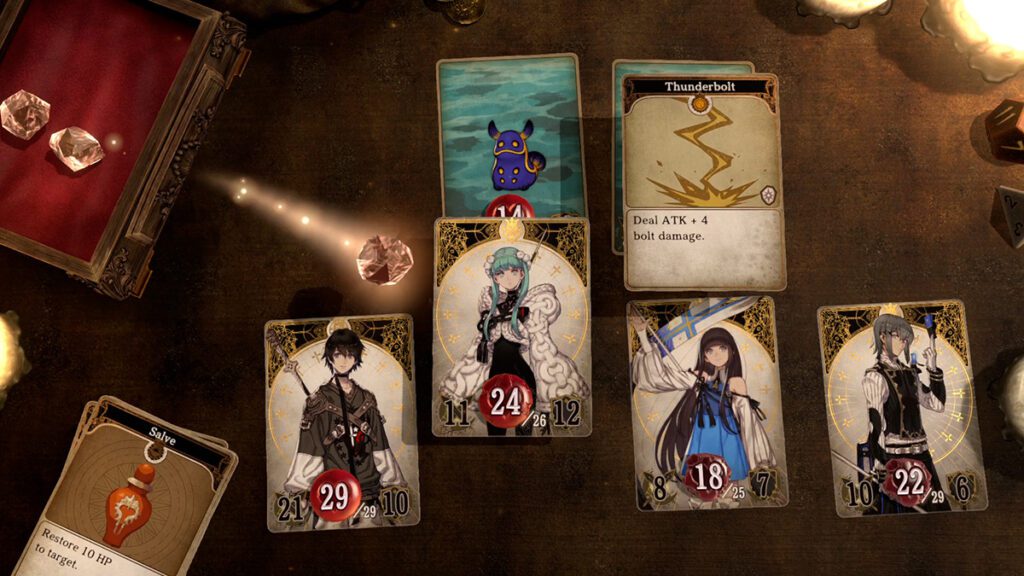Developed by: Alim
Published by: Square Enix
Released: February 17, 2022 (Playstation, PC, Switch)
Back in October 2021, Square Enix released the card based JRPG Voice of Cards: The Isle Dragon Roars. Then four months later Voice of Cards: The Forsaken Maiden releases in Febuary of 2022. The Forsaken Maiden is again led by Creative Director Yoko Taro and retains a similar battle system and aesthetic. Otherwise, it is a completely separate game. The Forsaken Maiden makes a few changes to the tone and gameplay, which result in a tighter and emotionally compelling experience.
Same Game, Different Deck
The Forsaken Maiden keeps the characters as cards and card tile based movement as the previous game. The battle system is also consistent. However, the unique story, engaging characters, and faster gameplay translate into a familiar, but new experience. JRPGs traditionally borrow systems and mechanics from others in a series, so having The Forsaken Maiden apply the same battle and movement creates a continuation and does not feel repetitive. Fortunately, the turn based battles capture the spirit of classic JRPGs. Voice of Cards, now a series, is a spiritual successor to classic 8 and 16-bit games. Players explore the game world, filled with random encounters, complete side quests, and resolve a larger plot. The high fantasy trappings of The Isle Dragon Roars are gone and replaced with a seafaring island-hopping adventure.
Gameplay
If you enjoyed the first Voice of Cards, The Forsaken Maiden is more of the same. Players move a token across the game board represented by cards that flip to reveal the map. Battles play out in a traditional turn based manner with the characters, enemies, and attacks depicted on cards. The battles use a gem/mana system where stronger attacks and buffs/debuffs require more gems to use. This system aligns with many other collectible card battler games. However, it also feels like a direct extension of traditional JRPG mana systems. This familiarity creates a sense of comfort and ease to the game. Similar to other deck based games, battles do require some strategy, especially at higher levels and with bosses. Managing status effects, exploiting enemies’ weaknesses, and reserving gems for specific attacks all creates engaging, if not, slow paced gameplay.
Fortunately, The Forsaken Maiden adds a fast game speed to the formula. This one shift speeds the game up significantly. The faster speed reduces the time watching spells and attacks, and helps to maintain a stronger sense of momentum for the story. This single change makes The Forbidden Maiden easier to recommend over The Isle Dragon Roars. Consequently, for a game that rewards some level of grinding, the increased speed makes the leveling more enjoyable.
Graphics & Sound
The exploration and battling are accompanied by an excellent score and music directed by Keiichi Okabe. Okabe collaborated with Yoko Taro on the Nier series. And there are similar haunting melodies here. Futhermore, there is even DLC that replaces the original music with music from Nier: Automata. Both are appropriate for the adventurous story filled with internal conflict.
The graphics are minimalist in general given that everything is represented on static card images. Yet, the character designs by Kimihiko Fujisaka are beautiful and pair nicely with the traditional JRPG feel of the game. Fujisaka is also a long time Yoko Taro collaborator dating back the Drakengard series. Even though, the card based nature of the game does not push a graphics engine, the visuals are striking.
Story
The Voice of Cards series creates a tabletop role-playing atmosphere with both the design and the inclusion of a game master/narrator. The Isle Dragon Roars’ narrator had a sense of humor with worked well with the characters. However, The Forsaken Maiden uses a different narrator. The new narrator captures the sense of innocence and sadness present throughout the story.
Barren, the main character, and his friend Laty exist on an island without a maiden. The maidens protect the island and bring life to it. Carrying on JRPG themes, Laty does not speak and little of her backstory is known at the start of the game. Throughout the game Barren learns more about Laty and her repressed memories. Laty’s memories are explored further in the alternate world of her “Hearts Domain.” This dark world deepens the sense of loss and trauma that accompanies the maidens.
The story charges Laty and Barren, along with their spirit guide Lac, with discovering the other four maidens of the islands and using their relics to transform Laty into a maiden. Each maiden and their island contains its’ own story and quests with characters and conflicts that explore emotional themes. True to Yoko Taro form, there are a number of twists throughout and the final act is emotionally complex.
The Forsaken Maiden is a Yoko Taro story, through and through. Consequently, it is engaging, heartfelt, and thought-provoking. In fact, given the card based gameplay it is one of Yoko Taro’s most approachable creations.
For Destiny & Love
Voice of Cards: The Forsaken Maiden is a gift for JPRG fans. It retains a number of classic genre conventions and gameplay. It also will appeal to deck based fans through its’ approachable card mechanics. The emotional melancholy story fits nicely with the leisurely pace of the game systems. And the fast game speed is a necessary improvement. The overall game is around 15-20 depending on the amount of grinding and the game speed. This compact (for JRPGs) experience is a strong second outing for the series and a worthy addition to the genre.




